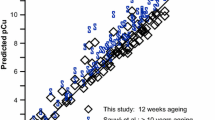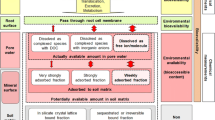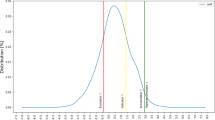Abstract
Regulatory assessment of lead (Pb) in contaminated soils is still expressed primarily as total Pb concentrations in soil. In this study, we estimated effective concentrations (ECx) of Pb to Cucumis sativa L. (cucumber) focusing primarily on pore-water Pb data from 10 different soils after 12 weeks ageing. Phytotoxicity expressed in terms of Pb2+ was observed to occur in the nanomolar range in neutral to alkaline soils (EC50 values 90 to 853 nM) and micromolar levels for acidic soils (EC50 values 7.35 to 9.66 μM). Internal Pb concentrations relating to toxicity (PT50) in roots and shoots also decreased with increasing pore-water pH (R 2 = 0.52 to 0.53). From a series of dose-response studies, we developed transfer functions predicting Pb uptake in C. sativa and we validated these functions with long-term Pb contaminated soils. The significant independent parameters were pore-water Pb2+ and dissolved Pb plus dissolved organic carbon (DOC). The observed RMSE for the Pb-DOC model and Pb2+ were 2.6 and 8.8, respectively. The Pb-DOC model tended to under-predict Pb, whilst Pb2+ tended to over-predict accumulation despite reasonable RMSE values. Further validation is needed in soils with higher pore-water Pb solubility.




Similar content being viewed by others
References
Agency for Toxic Substances and Disease Registry (ATSDR). Toxicological profile for Lead. Atlanta, GA: U.S. Department of Health and Human Services, Public Health Service. Available online at http://www.atsdr.cdc.gov/spl/
Antunes PMC, Hale BA, Ryan AC (2007) Toxicity versus accumulation of barley plants exposed to copper in the presence of metal buffers: progress towards development of a terrestrial biotic ligand model. Environ Toxicol Chem 26:2282–2289
Bradl HB (2004) Adsorption of heavy metal ions on soils and soils constituents. J Colloid Interface Sci 277:1–18
Cheyns K, Peeters S, Delcourt D, Smolders E (2012) Lead phytotoxicity in soils and nutrient solutions is related to lead induced phosphorus deficiency. Environ Pollut 164:242–247
De Schamphelaere KAC, Janssen CR (2002) A biotic ligand model predicting acute copper toxicity for daphnia magna: the effects of calcium, magnesium, sodium, potassium, and pH. Environ Sci Technol 36:48–54
Degryse F, Smolders E, Parker D (2009) Partitioning of metals (Cd, Co, Cu, Ni, Pb, Zn) in soils: concepts, methodologies, prediction and applications—a review. Eur J Soil Sci 60:590–612
Efroymson RA, Sample BE, Suter GW (2001) Uptake of inorganic chemicals from soil by plant leaves: regressions of field data. Environ Toxicol Chem 20:2561–2571
Fischer S, Kuhnlenz T, Thieme M, Schmidt H, Clemens S (2014) Analysis of plant Pb tolerance at realistic submicromolar concentrations demonstrates the role of phytochelatin synthesis for Pb detoxification. Environ Sci Technol 48:7552–7559
Ivezić V, Almås ÅR, Singh BR (2012) Predicting the solubility of Cd, Cu, Pb and Zn in uncontaminated Croatian soils under different land uses by applying established regression models. Geoderma 170:89–95
Kader M, Lamb DT, Correll R, Megharaj M, Naidu R (2015) Pore-water chemistry explains zinc phytotoxicity in soil. Ecotoxicol Environ Saf 122:252–259
Kader M, Lamb DT, Megharaj M, Naidu R (2016a) Sorption parameters as a predictor of arsenic phytotoxicity in Australian soils. Geoderma 265:103–110
Kader M, Lamb DT, Wang L, Megharaj M, Naidu R (2016b) Predicting copper phytotoxicity based on pore-water pCu. Ecotoxicology. 1–10
Kopittke PM, Asher CJ, Blamey F, Menzies NW (2007a) Toxic effects of Pb2+ on the growth and mineral nutrition of signal grass (Brachiaria decumbens) and Rhodes grass (Chloris gayana). Plant Soil 300:127–136
Lamb DT, Ming H, Megharaj M, Naidu R (2010) Phytotoxicity and accumulation of lead in Australian native vegetation. Arch Environ Contam Toxicol 58:613–621
Lamb DT, Matanitobua VP, Palanisami T, Megharaj M, Naidu R (2013) Bioavailability of barium to plants and invertebrates in soils contaminated by barite. Environ Sci Technol 47:4670–4676
Langdon CJ, Hodson ME, Arnold RE, Black S (2005) Survival, Pb-uptake and behaviour of three species of earthworm in Pb treated soils determined using an OECD-style toxicity test and a soil avoidance test. Environ Pollut 138:368–375
Lidsky T, Schneider J (2006) Adverse effects of childhood lead poisoning: the clinical neuropsychological perspective. Environ Res 100:284–293
Lofts S, Spurgeon DJ, Svendsen C, Tip** E (2004) Deriving soil critical limits for Cu, Zn, Cd, and Pb: a method based on free ion concentrations. Environ Sci Technol 38:3623–3631
Mahimairaja S, Bolan NS, Adriano DC, Robinson B (2005) Arsenic contamination and its risk management in complex environmental settings, advances in agronomy. Academic Press, pp. 1–82
McBride M (2002) Cadmium uptake by crops estimated from soil total Cd and pH. Soil Sci 167:62–67
McBride M, Sauve S, Hendershot W (1997) Solubility control of Cu, Zn, Cd and Pb in contaminated soils. Eur J Soil Sci 48:337–346
Ming H, He W, Lamb DT, Megharaj M, Naidu R (2012) Bioavailability of lead in contaminated soil depends on the nature of bioreceptor. Ecotoxicol Environ Saf 78:344–350
Naidu R, Bolan NS, Kookana RS, Tiller K (1994) Ionic-strength and pH effects on the sorption of cadmium and the surface charge of soils. Eur J Soil Sci 45:419–429
Naidu R, Semple KT, Megharaj M, Juhasz AL, Bolan NS, Gupta S, Clothier B, Schulin R, Chaney R (2008a) Bioavailability, Definition, Assessment and Implications for Risk Assessment. In: Naidu R (ed) Chemical Bioavailability in Terrestrial Environment. Elsevier, Amsterdam, pp 39–52
Naidu R, Pollard SJT, Bolan NS, Owens G, Pruszinski AW (2008a): Bioavailability: the underlying basis for risk-based land management. In: A.E. Hartemink ABM , Ravendra N (Editors), Developments in Soil Science. Elsevier, pp. 53–72
Pampura T, Groenenberg JE, Lofts S, Priputina I (2007) Validation of Transfer Functions Predicting Cd and Pb Free Metal Ion Activity in Soil Solution as a Function of Soil Characteristics and Reactive Metal Content. Water Air Soil Pollut 184:217–234
Romero-Freire A, Martin Peinado FJ, van Gestel CAM (2015) Effect of soil properties on the toxicity of Pb: assessment of the appropriateness of guideline values. J Hazard Mater 289:46–53
Rotkittikhun P, Kruatrachue M, Chaiyarat R, Ngernsansaruay C, Pokethitiyook P, Paijitprapaporn A, Baker AJ (2006) Uptake and accumulation of lead by plants from the Bo Ngam lead mine area in Thailand. Environ Pollut 144:681–688
Sanderson P, Naidu R, Bolan N, Bowman M (2011) Critical review on chemical stabilization of metal contaminants in shooting range soils. J Hazard, Toxic, Radioact Waste 16:258–272
Sanderson P, Naidu R, Bolan N (2014) Ecotoxicity of chemically stabilised metal(loid)s in shooting range soils. Ecotoxicol Environ Saf 100:201–208
Sauvé S, McBride MB, Hendershot WH (1997) Speciation of lead in contaminated soils. Environ Pollut 98:149–155
Sauve S, McBride M, Hendershot W (1998) Soil solution speciation of lead (II): effects of organic matter and pH. Soil Sci Soc Am J 62:618–621
Sauvé S, Dumestre A, McBride M, Hendershot W (1998) Derivation of soil quality criteria using predicted chemical speciation of Pb2+ and Cu2+. Environ Toxicol Chem 17:1481–1489
Semple KT, Doick KJ, Jones KC, Burauel P, Craven A, Harms H (2004) Peer reviewed: defining bioavailability and bioaccessibility of contaminated soil and sediment is complicated. Environ Sci Technol 38:228A–231A
Smolders E, Oorts K, Van Sprang P, Schoeters I, Janssen CR, McGrath SP, McLaughlin MJ (2009) Toxicity of trace metals in soil as affected by soil type and aging after contamination: using calibrated bioavailability models to set ecological soil standards. Environ Toxicol Chem 28:1633–1642
Smolders E, Oorts K, Peeters S, Lanno R, Cheyns K (2015) Toxicity in lead salt spiked soils to plants, invertebrates and microbial processes: unraveling effects of acidification, salt stress and ageing reactions. Sci Total Environ 536:223–231
Song N, Zhong X, Li B, Li J, Wei D, Ma Y (2014) Development of a multi-species biotic ligand model predicting the toxicity of trivalent chromium to barley root elongation in solution culture
Stevens DP, McLaughlin MJ, Heinrich T (2003) Determining toxicity of lead and zinc runoff in soils: salinity effects on metal partitioning and on phytotoxicity. Environ Toxicol Chem 22:3017–3024
Thakali S, Allen HE, Di Toro DM, Ponizovsky AA, Rooney CP, Zhao F-J, McGrath SP (2006) A Terrestrial Biotic Ligand Model. 1. Development and Application to Cu and Ni Toxicities to Barley Root Elongation in Soils. Environ Sci Technol 40:7085–7093
Tip** E, Lofts S (2015) Testing WHAM-FTOX with laboratory toxicity data for mixtures of metals (Cu, Zn, Cd, Ag, Pb). Environ Toxicol Chem 34:788–798
Weng L, Lexmond TM, Wolthoorn A, Temminghoff EJ, van Riemsdijk WH (2003) Phytotoxicity and bioavailability of nickel: chemical speciation and bioaccumulation. Environ Toxicol Chem 22:2180–2187
**an X, Shokohifard GI (1989) Effect of pH on chemical forms and plant availability of cadmium, zinc, and lead in polluted soils. Water Air Soil Pollut 45:265–273
Acknowledgments
We would like to thank the Cooperative Research Centre for Contamination Assessment and Remediation of the Environment (CRC CARE Pty Ltd) for providing fund for this study. In addition, we would like to thank Mr. Ramkrishna Nirola and Ms. Sedigheh Abbasi for their valuable assistance in soil sampling.
Author information
Authors and Affiliations
Corresponding author
Additional information
Responsible editor: Zhihong Xu
Rights and permissions
About this article
Cite this article
Kader, M., Lamb, D.T., Mahbub, K.R. et al. Predicting plant uptake and toxicity of lead (Pb) in long-term contaminated soils from derived transfer functions. Environ Sci Pollut Res 23, 15460–15470 (2016). https://doi.org/10.1007/s11356-016-6696-z
Received:
Accepted:
Published:
Issue Date:
DOI: https://doi.org/10.1007/s11356-016-6696-z




